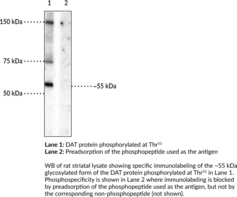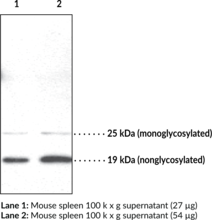Cayman
Showing 18901–19050 of 45550 results
-
Dofetilide is a class III antiarrhythmic agent that prolongs cardiac action potential duration by selectively inhibiting the rapidly activating inward rectifying component of net delayed rectifier K+ current (IC50 = 31.5 nM in guinea pig cardiomyocytes).{24130} However, at 1 μM, dofetilide has pro-arrhythmic activity, inducing early afterdepolarizations (prolonged repolarization) in cell models and Torsade de Pointes in a rabbit screen for proarrhythmic properties when administered at a dose of 10 mg/kg.{24131} Formulations containing dofetilide have been used in the treatment of highly symptomatic atrial fibrillation and the conversion of flutter to normal sinus rhythm.{24132}
Brand:CaymanSKU:-Dofetilide-d4 is intended for use as an internal standard for the quantification of dofetilide (Item No. 15045) by GC- or LC-MS. Dofetilide is a class III antiarrhythmic agent that prolongs cardiac action potential duration by selectively inhibiting the rapidly activating inward rectifying component of net delayed rectifier K+ current (IC50 = 31.5 nM in guinea pig cardiomyocytes).{24130} However, at 1 μM, dofetilide has pro-arrhythmic activity, inducing early afterdepolarizations (prolonged repolarization) in cell models and Torsade de Pointes in a rabbit screen for proarrhythmic properties when administered at a dose of 10 mg/kg.{24131} Formulations containing dofetilide have been used in the treatment of highly symptomatic atrial fibrillation and the conversion of flutter to normal sinus rhythm.{24132}
Brand:CaymanSKU:26451 - 1 mgAvailable on backorder
Dofetilide-d4 is intended for use as an internal standard for the quantification of dofetilide (Item No. 15045) by GC- or LC-MS. Dofetilide is a class III antiarrhythmic agent that prolongs cardiac action potential duration by selectively inhibiting the rapidly activating inward rectifying component of net delayed rectifier K+ current (IC50 = 31.5 nM in guinea pig cardiomyocytes).{24130} However, at 1 μM, dofetilide has pro-arrhythmic activity, inducing early afterdepolarizations (prolonged repolarization) in cell models and Torsade de Pointes in a rabbit screen for proarrhythmic properties when administered at a dose of 10 mg/kg.{24131} Formulations containing dofetilide have been used in the treatment of highly symptomatic atrial fibrillation and the conversion of flutter to normal sinus rhythm.{24132}
Brand:CaymanSKU:26451 - 500 µgAvailable on backorder
DOI (hydrochloride) (Item No. 13885) is an analytical reference standard categorized as an amphetamine and phenethylamine. DOI has psychotomimetic properties and abuse of DOI has been reported.{49666,20685,21517} This product is intended for research and forensic applications.
Brand:CaymanSKU:-DOI (hydrochloride) (Item No. 13885) is an analytical reference standard categorized as an amphetamine and phenethylamine. DOI has psychotomimetic properties and abuse of DOI has been reported.{49666,20685,21517} This product is intended for research and forensic applications.
Brand:CaymanSKU:-DOI (hydrochloride) (Item No. 13885) is an analytical reference standard categorized as an amphetamine and phenethylamine. DOI has psychotomimetic properties and abuse of DOI has been reported.{49666,20685,21517} This product is intended for research and forensic applications.
Brand:CaymanSKU:-Dolasetron is a potent antagonist of the serotonin (5-HT) receptor subtype 5-HT3 with a Ki value of 20 nM in a radioligand binding assay.{40077} It reversibly suppresses 5-HT-induced membrane current in voltage-clamped NGI108-15 cells (IC50 = 3.8 nM). Dolasetron is a prodrug that is metabolized by carbonyl reductase to form reduced dolasetron, the major pharmacologically active metabolite in humans.{40078} Formulations containing dolasetron are under investigation for utility in treating chemotherapy-induced nausea and vomiting.{40079}
Brand:CaymanSKU:22234 -Out of stock
Dolasetron is a potent antagonist of the serotonin (5-HT) receptor subtype 5-HT3 with a Ki value of 20 nM in a radioligand binding assay.{40077} It reversibly suppresses 5-HT-induced membrane current in voltage-clamped NGI108-15 cells (IC50 = 3.8 nM). Dolasetron is a prodrug that is metabolized by carbonyl reductase to form reduced dolasetron, the major pharmacologically active metabolite in humans.{40078} Formulations containing dolasetron are under investigation for utility in treating chemotherapy-induced nausea and vomiting.{40079}
Brand:CaymanSKU:22234 -Out of stock
Dolasetron is a potent antagonist of the serotonin (5-HT) receptor subtype 5-HT3 with a Ki value of 20 nM in a radioligand binding assay.{40077} It reversibly suppresses 5-HT-induced membrane current in voltage-clamped NGI108-15 cells (IC50 = 3.8 nM). Dolasetron is a prodrug that is metabolized by carbonyl reductase to form reduced dolasetron, the major pharmacologically active metabolite in humans.{40078} Formulations containing dolasetron are under investigation for utility in treating chemotherapy-induced nausea and vomiting.{40079}
Brand:CaymanSKU:22234 -Out of stock
Dolasetron is a potent antagonist of the serotonin (5-HT) receptor subtype 5-HT3 with a Ki value of 20 nM in a radioligand binding assay.{40077} It reversibly suppresses 5-HT-induced membrane current in voltage-clamped NGI108-15 cells (IC50 = 3.8 nM). Dolasetron is a prodrug that is metabolized by carbonyl reductase to form reduced dolasetron, the major pharmacologically active metabolite in humans.{40078} Formulations containing dolasetron are under investigation for utility in treating chemotherapy-induced nausea and vomiting.{40079}
Brand:CaymanSKU:22234 -Out of stock
Dolastatin 15 is a peptide that has been found in D. auricularia and has anticancer activity.{55029,55030,55031} It induces cell cycle arrest at the G2/M phase and inhibits proliferation of JVM-2 and EHEB human B cell leukemia cells when used at a concentration of 1 nM.{55029} Dolastatin 15 also inhibits proliferation of RPMI-8826, U266, and IM-9 human multiple myeloma cells (IC50s = 0.5-1 nM), as well as a panel of colon and ovarian cancer cell lines (IC50s = 0.031-1.8 nM).{55030,55031} It reduces tumor growth in a CH1 mouse xenograft model when administered at a dose of 5.25 mg/kg per day.{55031}
Brand:CaymanSKU:30144 - 1 mgAvailable on backorder
Dolutegravir is a potent inhibitor of HIV integrase with an IC50 value of 2.7 nM for HIV-1 integrase-catalyzed strand transfer in vitro.{40090} It inhibits HIV-1 viral replication (EC50 = 0.51 nM) in peripheral blood mononuclear cells (PBMCs). The cytotoxic concentration (CC50) values for dolutegravir in unstimulated and stimulated PBMCs are 189 and 52 µM, respectively, resulting in a therapeutic index of at least 9,400. It prevents replication of several HIV-1 strains (EC50s = 0.36-2.1 nM) that are resistant to nucleoside reverse transcriptase inhibitors (NRTIs), non-nucleoside reverse transcriptase inhibitors (NNRTIs), and protease inhibitors and impairs their ability to infect CIP4 cells.{40090,40091} Formulations containing dolutegravir have been used to treat HIV-1 infection in humans.{40092}
Brand:CaymanSKU:22191 -Out of stock
Dolutegravir is a potent inhibitor of HIV integrase with an IC50 value of 2.7 nM for HIV-1 integrase-catalyzed strand transfer in vitro.{40090} It inhibits HIV-1 viral replication (EC50 = 0.51 nM) in peripheral blood mononuclear cells (PBMCs). The cytotoxic concentration (CC50) values for dolutegravir in unstimulated and stimulated PBMCs are 189 and 52 µM, respectively, resulting in a therapeutic index of at least 9,400. It prevents replication of several HIV-1 strains (EC50s = 0.36-2.1 nM) that are resistant to nucleoside reverse transcriptase inhibitors (NRTIs), non-nucleoside reverse transcriptase inhibitors (NNRTIs), and protease inhibitors and impairs their ability to infect CIP4 cells.{40090,40091} Formulations containing dolutegravir have been used to treat HIV-1 infection in humans.{40092}
Brand:CaymanSKU:22191 -Out of stock
Dolutegravir is a potent inhibitor of HIV integrase with an IC50 value of 2.7 nM for HIV-1 integrase-catalyzed strand transfer in vitro.{40090} It inhibits HIV-1 viral replication (EC50 = 0.51 nM) in peripheral blood mononuclear cells (PBMCs). The cytotoxic concentration (CC50) values for dolutegravir in unstimulated and stimulated PBMCs are 189 and 52 µM, respectively, resulting in a therapeutic index of at least 9,400. It prevents replication of several HIV-1 strains (EC50s = 0.36-2.1 nM) that are resistant to nucleoside reverse transcriptase inhibitors (NRTIs), non-nucleoside reverse transcriptase inhibitors (NNRTIs), and protease inhibitors and impairs their ability to infect CIP4 cells.{40090,40091} Formulations containing dolutegravir have been used to treat HIV-1 infection in humans.{40092}
Brand:CaymanSKU:22191 -Out of stock
Dolutegravir is a potent inhibitor of HIV integrase with an IC50 value of 2.7 nM for HIV-1 integrase-catalyzed strand transfer in vitro.{40090} It inhibits HIV-1 viral replication (EC50 = 0.51 nM) in peripheral blood mononuclear cells (PBMCs). The cytotoxic concentration (CC50) values for dolutegravir in unstimulated and stimulated PBMCs are 189 and 52 µM, respectively, resulting in a therapeutic index of at least 9,400. It prevents replication of several HIV-1 strains (EC50s = 0.36-2.1 nM) that are resistant to nucleoside reverse transcriptase inhibitors (NRTIs), non-nucleoside reverse transcriptase inhibitors (NNRTIs), and protease inhibitors and impairs their ability to infect CIP4 cells.{40090,40091} Formulations containing dolutegravir have been used to treat HIV-1 infection in humans.{40092}
Brand:CaymanSKU:22191 -Out of stock
DOM is an amphetamine with dose-dependent psychotomimetic and hallucinogenic effects.{21076} It potently binds and activates serotonin 5-HT2 receptors (pA2 = 7.12).{20184} DOM is classified as a Schedule I compound in the United States. This product is intended for research and forensic purposes.
Brand:CaymanSKU:-Domiphen is a quaternary ammonium compound and cationic surfactant with antimicrobial activity.{53601,53602} It is active against A. viscosus, A. naeslundii, S. mutans, E. coli, and L. monocytogenes bacteria and inhibits C. neoformans yeast growth and spore germination.{53601,53602,53603,53604} It also inhibits the human-ether-a-go-go-related gene (hERG) channel (IC50 = 1.5 μM in a whole-cell patch-clamp assay).{53605} Formulations containing domiphen have been used as antiseptics, disinfectants, and biocides in industrial, agricultural, veterinary, and clinical applications.
Brand:CaymanSKU:30276 - 100 gAvailable on backorder
Domiphen is a quaternary ammonium compound and cationic surfactant with antimicrobial activity.{53601,53602} It is active against A. viscosus, A. naeslundii, S. mutans, E. coli, and L. monocytogenes bacteria and inhibits C. neoformans yeast growth and spore germination.{53601,53602,53603,53604} It also inhibits the human-ether-a-go-go-related gene (hERG) channel (IC50 = 1.5 μM in a whole-cell patch-clamp assay).{53605} Formulations containing domiphen have been used as antiseptics, disinfectants, and biocides in industrial, agricultural, veterinary, and clinical applications.
Brand:CaymanSKU:30276 - 25 gAvailable on backorder
Domiphen is a quaternary ammonium compound and cationic surfactant with antimicrobial activity.{53601,53602} It is active against A. viscosus, A. naeslundii, S. mutans, E. coli, and L. monocytogenes bacteria and inhibits C. neoformans yeast growth and spore germination.{53601,53602,53603,53604} It also inhibits the human-ether-a-go-go-related gene (hERG) channel (IC50 = 1.5 μM in a whole-cell patch-clamp assay).{53605} Formulations containing domiphen have been used as antiseptics, disinfectants, and biocides in industrial, agricultural, veterinary, and clinical applications.
Brand:CaymanSKU:30276 - 50 gAvailable on backorder
Domoic acid is a kainate receptor agonist, neurotoxin, and an analog of (−)-(α)-kainic acid (Item No. 78050).{41911} Domoic acid binds to GluR5, GluR6, and GluR7 recombinant homomeric kainate receptors (Kis = 2, 6, and 37 nM, respectively), KA-1 and KA-2 kainate receptors, and the GluR4 AMPA receptor. It also binds to kainate and AMPA receptors in rat forebrain membranes (IC50s = 4.9 and 9.2 nM, respectively).{41912} In vitro, domoic acid depolarizes primary motor neurons and dorsal root fibers isolated from newborn rats at potencies of 2.2 and 34 relative to kainate, respectively.{41913} In vivo, domoic acid induces convulsive behavior in rats (ED50 = 0.07 nmol/animal) and induces seizures in mice with a 50% convulsive dose (CD50) value of 0.09 nmol/animal.{41914}
Brand:CaymanSKU:21433 -Out of stock
Domoic acid is a kainate receptor agonist, neurotoxin, and an analog of (−)-(α)-kainic acid (Item No. 78050).{41911} Domoic acid binds to GluR5, GluR6, and GluR7 recombinant homomeric kainate receptors (Kis = 2, 6, and 37 nM, respectively), KA-1 and KA-2 kainate receptors, and the GluR4 AMPA receptor. It also binds to kainate and AMPA receptors in rat forebrain membranes (IC50s = 4.9 and 9.2 nM, respectively).{41912} In vitro, domoic acid depolarizes primary motor neurons and dorsal root fibers isolated from newborn rats at potencies of 2.2 and 34 relative to kainate, respectively.{41913} In vivo, domoic acid induces convulsive behavior in rats (ED50 = 0.07 nmol/animal) and induces seizures in mice with a 50% convulsive dose (CD50) value of 0.09 nmol/animal.{41914}
Brand:CaymanSKU:21433 -Out of stock
Domperidone is a dopamine D2 receptor antagonist (Ki = 0.3 nM in CHO cells expressing the rat receptor).{30683,53246} It is selective for dopamine D2 over D3 receptors (Ki = 9.5 nM).{30683} Domperidone (0.5-5 μg/kg) inhibits dipropyl dopamine-induced femoral vasodilation in dogs, indicating dopamine D2 receptor antagonist activity, and has no effect on dopamine-induced vasodilation in the renal vascular bed in dogs when administered at doses up to 5 mg/kg, indicating a lack of activity at dopamine D1 receptors.{53246} Domperidone (0.5 mg/kg) prevents dopamine-induced decreases in gastric antral motility induced by pentagastrin (Item No. 28546) in dogs.{53247} It inhibits apomorphine-induced emesis in dogs (ED50 = 0.031 mg/kg, p.o.).{39860} Domperidone also increases serum levels of prolactin in male rats.{46567}
Brand:CaymanSKU:-Available on backorder
Domperidone is a dopamine D2 receptor antagonist (Ki = 0.3 nM in CHO cells expressing the rat receptor).{30683,53246} It is selective for dopamine D2 over D3 receptors (Ki = 9.5 nM).{30683} Domperidone (0.5-5 μg/kg) inhibits dipropyl dopamine-induced femoral vasodilation in dogs, indicating dopamine D2 receptor antagonist activity, and has no effect on dopamine-induced vasodilation in the renal vascular bed in dogs when administered at doses up to 5 mg/kg, indicating a lack of activity at dopamine D1 receptors.{53246} Domperidone (0.5 mg/kg) prevents dopamine-induced decreases in gastric antral motility induced by pentagastrin (Item No. 28546) in dogs.{53247} It inhibits apomorphine-induced emesis in dogs (ED50 = 0.031 mg/kg, p.o.).{39860} Domperidone also increases serum levels of prolactin in male rats.{46567}
Brand:CaymanSKU:-Available on backorder
Domperidone is a dopamine D2 receptor antagonist (Ki = 0.3 nM in CHO cells expressing the rat receptor).{30683,53246} It is selective for dopamine D2 over D3 receptors (Ki = 9.5 nM).{30683} Domperidone (0.5-5 μg/kg) inhibits dipropyl dopamine-induced femoral vasodilation in dogs, indicating dopamine D2 receptor antagonist activity, and has no effect on dopamine-induced vasodilation in the renal vascular bed in dogs when administered at doses up to 5 mg/kg, indicating a lack of activity at dopamine D1 receptors.{53246} Domperidone (0.5 mg/kg) prevents dopamine-induced decreases in gastric antral motility induced by pentagastrin (Item No. 28546) in dogs.{53247} It inhibits apomorphine-induced emesis in dogs (ED50 = 0.031 mg/kg, p.o.).{39860} Domperidone also increases serum levels of prolactin in male rats.{46567}
Brand:CaymanSKU:-Available on backorder
Domperidone is a dopamine D2 receptor antagonist (Ki = 0.3 nM in CHO cells expressing the rat receptor).{30683,53246} It is selective for dopamine D2 over D3 receptors (Ki = 9.5 nM).{30683} Domperidone (0.5-5 μg/kg) inhibits dipropyl dopamine-induced femoral vasodilation in dogs, indicating dopamine D2 receptor antagonist activity, and has no effect on dopamine-induced vasodilation in the renal vascular bed in dogs when administered at doses up to 5 mg/kg, indicating a lack of activity at dopamine D1 receptors.{53246} Domperidone (0.5 mg/kg) prevents dopamine-induced decreases in gastric antral motility induced by pentagastrin (Item No. 28546) in dogs.{53247} It inhibits apomorphine-induced emesis in dogs (ED50 = 0.031 mg/kg, p.o.).{39860} Domperidone also increases serum levels of prolactin in male rats.{46567}
Brand:CaymanSKU:-Available on backorder
Domperidone-d6 is intended for use as an internal standard for the quantification of domperidone (Item No. 18875) by GC- or LC-MS. Domperidone is a dopamine D2 receptor antagonist (Ki = 0.3 nM in CHO cells expressing the rat receptor).{30683,53246} It is selective for dopamine D2 over D3 receptors (Ki = 9.5 nM).{30683} Domperidone (0.5-5 µg/kg) inhibits dipropyl dopamine-induced femoral vasodilation in dogs, indicating dopamine D2 receptor antagonist activity, and has no effect on dopamine-induced vasodilation in the renal vascular bed in dogs when administered at doses up to 5 mg/kg, indicating a lack of activity at dopamine D1 receptors.{53246} Domperidone (0.5 mg/kg) prevents dopamine-induced decreases in gastric antral motility induced by pentagastrin (Item No. 28546) in dogs.{53247} It inhibits apomorphine-induced emesis in dogs (ED50 = 0.031 mg/kg, p.o.).{39860} Domperidone also increases serum levels of prolactin in male rats.{46567}
Brand:CaymanSKU:30152 - 1 mgAvailable on backorder
Acetylcholine is a neurotransmitter involved in neural signaling throughout the body. Donepezil is a reversible acetylcholinesterase inhibitor that readily crosses the blood-brain barrier to reduce the breakdown of acetylcholine.{17054} It has a half-life in circulation of about 70 hours. As acetylcholine modulates plasticity, excitability, and arousal in the central nervous system, donepezil is commonly used in the treatment of Alzheimer’s disease to improve cognition, memory, and behavior. In this way, it is intended to prevent or reverse dementia. Studies on these effects have been equivocal, indicating that more research into the therapeutic potential of donepezil is warranted.
Brand:CaymanSKU:-Acetylcholine is a neurotransmitter involved in neural signaling throughout the body. Donepezil is a reversible acetylcholinesterase inhibitor that readily crosses the blood-brain barrier to reduce the breakdown of acetylcholine.{17054} It has a half-life in circulation of about 70 hours. As acetylcholine modulates plasticity, excitability, and arousal in the central nervous system, donepezil is commonly used in the treatment of Alzheimer’s disease to improve cognition, memory, and behavior. In this way, it is intended to prevent or reverse dementia. Studies on these effects have been equivocal, indicating that more research into the therapeutic potential of donepezil is warranted.
Brand:CaymanSKU:-Acetylcholine is a neurotransmitter involved in neural signaling throughout the body. Donepezil is a reversible acetylcholinesterase inhibitor that readily crosses the blood-brain barrier to reduce the breakdown of acetylcholine.{17054} It has a half-life in circulation of about 70 hours. As acetylcholine modulates plasticity, excitability, and arousal in the central nervous system, donepezil is commonly used in the treatment of Alzheimer’s disease to improve cognition, memory, and behavior. In this way, it is intended to prevent or reverse dementia. Studies on these effects have been equivocal, indicating that more research into the therapeutic potential of donepezil is warranted.
Brand:CaymanSKU:-Acetylcholine is a neurotransmitter involved in neural signaling throughout the body. Donepezil is a reversible acetylcholinesterase inhibitor that readily crosses the blood-brain barrier to reduce the breakdown of acetylcholine.{17054} It has a half-life in circulation of about 70 hours. As acetylcholine modulates plasticity, excitability, and arousal in the central nervous system, donepezil is commonly used in the treatment of Alzheimer’s disease to improve cognition, memory, and behavior. In this way, it is intended to prevent or reverse dementia. Studies on these effects have been equivocal, indicating that more research into the therapeutic potential of donepezil is warranted.
Brand:CaymanSKU:-Donepezil N-oxide is an active metabolite of the acetylcholinesterase inhibitor donepezil (Item No. 13245).{47251} Donepezil N-oxide inhibits cholinesterase (ChE) activity in human erythrocytes in a concentration-dependent manner, exhibiting 45.5% inhibition when used at a concentration of 20 µM.{47252}
Brand:CaymanSKU:27174 - 1 mgAvailable on backorder
Donepezil N-oxide is an active metabolite of the acetylcholinesterase inhibitor donepezil (Item No. 13245).{47251} Donepezil N-oxide inhibits cholinesterase (ChE) activity in human erythrocytes in a concentration-dependent manner, exhibiting 45.5% inhibition when used at a concentration of 20 µM.{47252}
Brand:CaymanSKU:27174 - 10 mgAvailable on backorder
Donepezil N-oxide is an active metabolite of the acetylcholinesterase inhibitor donepezil (Item No. 13245).{47251} Donepezil N-oxide inhibits cholinesterase (ChE) activity in human erythrocytes in a concentration-dependent manner, exhibiting 45.5% inhibition when used at a concentration of 20 µM.{47252}
Brand:CaymanSKU:27174 - 5 mgAvailable on backorder
Donepezil N-oxide is an active metabolite of the acetylcholinesterase inhibitor donepezil (Item No. 13245).{47251} Donepezil N-oxide inhibits cholinesterase (ChE) activity in human erythrocytes in a concentration-dependent manner, exhibiting 45.5% inhibition when used at a concentration of 20 µM.{47252}
Brand:CaymanSKU:27174 - 500 µgAvailable on backorder
Donepezil-d4 (hydrochloride) (Item No. 18251) is intended for use as an internal standard for the quantification of donepezil (Item No. 13245) by GC- or LC-MS. Donepezil is a reversible acetylcholinesterase inhibitor (IC50 = 23 nM) that readily crosses the blood-brain barrier to reduce the breakdown of acetylcholine.{17054} As acetylcholine modulates plasticity, excitability, and arousal in the central nervous system, donepezil has been used to study cognition, memory, and behavior in animal models.{31795,30746}
Brand:CaymanSKU:-Available on backorder
Donepezil-d4 (hydrochloride) (Item No. 18251) is intended for use as an internal standard for the quantification of donepezil (Item No. 13245) by GC- or LC-MS. Donepezil is a reversible acetylcholinesterase inhibitor (IC50 = 23 nM) that readily crosses the blood-brain barrier to reduce the breakdown of acetylcholine.{17054} As acetylcholine modulates plasticity, excitability, and arousal in the central nervous system, donepezil has been used to study cognition, memory, and behavior in animal models.{31795,30746}
Brand:CaymanSKU:-Available on backorder
Donepezil-d4 (hydrochloride) (Item No. 18251) is intended for use as an internal standard for the quantification of donepezil (Item No. 13245) by GC- or LC-MS. Donepezil is a reversible acetylcholinesterase inhibitor (IC50 = 23 nM) that readily crosses the blood-brain barrier to reduce the breakdown of acetylcholine.{17054} As acetylcholine modulates plasticity, excitability, and arousal in the central nervous system, donepezil has been used to study cognition, memory, and behavior in animal models.{31795,30746}
Brand:CaymanSKU:-Available on backorder
DOPAL is an aldehyde product of the oxidative deamination of dopamine by monoamine oxidase.{29866} It can be further oxidized to 3,4-dihydroxyphenylacetic acid (DOPAC) by aldehyde dehydrogenase (ALDH) and, to a lesser extent reduced to 3,4-dihydroxyphenyl ethanol (DOPET; Item No. 70604). DOPAL is toxic to neurons.{29865,29867} It can also oligomerize and precipitate α-synuclein, an event associated with Parkinson’s disease.{29865} Mice lacking cytosolic and mitochondrial forms of ALDH display increased levels of DOPAL as well as neurodegeneration and motor dysfunction characteristic of Parkinson’s disease.{29868}
Brand:CaymanSKU:-Available on backorder
DOPAL is an aldehyde product of the oxidative deamination of dopamine by monoamine oxidase.{29866} It can be further oxidized to 3,4-dihydroxyphenylacetic acid (DOPAC) by aldehyde dehydrogenase (ALDH) and, to a lesser extent reduced to 3,4-dihydroxyphenyl ethanol (DOPET; Item No. 70604). DOPAL is toxic to neurons.{29865,29867} It can also oligomerize and precipitate α-synuclein, an event associated with Parkinson’s disease.{29865} Mice lacking cytosolic and mitochondrial forms of ALDH display increased levels of DOPAL as well as neurodegeneration and motor dysfunction characteristic of Parkinson’s disease.{29868}
Brand:CaymanSKU:-Available on backorder
DOPAL is an aldehyde product of the oxidative deamination of dopamine by monoamine oxidase.{29866} It can be further oxidized to 3,4-dihydroxyphenylacetic acid (DOPAC) by aldehyde dehydrogenase (ALDH) and, to a lesser extent reduced to 3,4-dihydroxyphenyl ethanol (DOPET; Item No. 70604). DOPAL is toxic to neurons.{29865,29867} It can also oligomerize and precipitate α-synuclein, an event associated with Parkinson’s disease.{29865} Mice lacking cytosolic and mitochondrial forms of ALDH display increased levels of DOPAL as well as neurodegeneration and motor dysfunction characteristic of Parkinson’s disease.{29868}
Brand:CaymanSKU:-Available on backorder
DOPAL is an aldehyde product of the oxidative deamination of dopamine by monoamine oxidase.{29866} It can be further oxidized to 3,4-dihydroxyphenylacetic acid (DOPAC) by aldehyde dehydrogenase (ALDH) and, to a lesser extent reduced to 3,4-dihydroxyphenyl ethanol (DOPET; Item No. 70604). DOPAL is toxic to neurons.{29865,29867} It can also oligomerize and precipitate α-synuclein, an event associated with Parkinson’s disease.{29865} Mice lacking cytosolic and mitochondrial forms of ALDH display increased levels of DOPAL as well as neurodegeneration and motor dysfunction characteristic of Parkinson’s disease.{29868}
Brand:CaymanSKU:-Available on backorder
Dopamine (hydrochloride) is an endogenous catecholamine neurotransmitter synthesized from the amino acid L-tyrosine that acts as an agonist at dopamine receptors (D1-5).{29765} Dopamine is mainly synthesized in the substantia nigra and ventral tegmental area, and is a precursor in norepinephrine and epinephrine biosynthesis. Dopamine-containing neurons in the brain are involved in reward-motivated behavior, motor control, and hormone release. Dopamine is also synthesized in the adrenal glands where it exerts peripheral paracrine functions including control of vasodilation, sodium excretion, insulin production, gastrointestinal motility, and the activity of lymphocytes.{29764,5481} Loss or damage of dopaminergic neurons in the substantia nigra is associated with Parkinson’s disease.{31766}
Brand:CaymanSKU:21992 -Out of stock
Dopamine (hydrochloride) is an endogenous catecholamine neurotransmitter synthesized from the amino acid L-tyrosine that acts as an agonist at dopamine receptors (D1-5).{29765} Dopamine is mainly synthesized in the substantia nigra and ventral tegmental area, and is a precursor in norepinephrine and epinephrine biosynthesis. Dopamine-containing neurons in the brain are involved in reward-motivated behavior, motor control, and hormone release. Dopamine is also synthesized in the adrenal glands where it exerts peripheral paracrine functions including control of vasodilation, sodium excretion, insulin production, gastrointestinal motility, and the activity of lymphocytes.{29764,5481} Loss or damage of dopaminergic neurons in the substantia nigra is associated with Parkinson’s disease.{31766}
Brand:CaymanSKU:21992 -Out of stock
Dopamine (hydrochloride) is an endogenous catecholamine neurotransmitter synthesized from the amino acid L-tyrosine that acts as an agonist at dopamine receptors (D1-5).{29765} Dopamine is mainly synthesized in the substantia nigra and ventral tegmental area, and is a precursor in norepinephrine and epinephrine biosynthesis. Dopamine-containing neurons in the brain are involved in reward-motivated behavior, motor control, and hormone release. Dopamine is also synthesized in the adrenal glands where it exerts peripheral paracrine functions including control of vasodilation, sodium excretion, insulin production, gastrointestinal motility, and the activity of lymphocytes.{29764,5481} Loss or damage of dopaminergic neurons in the substantia nigra is associated with Parkinson’s disease.{31766}
Brand:CaymanSKU:21992 -Out of stock
Dopamine (hydrochloride) is an endogenous catecholamine neurotransmitter synthesized from the amino acid L-tyrosine that acts as an agonist at dopamine receptors (D1-5).{29765} Dopamine is mainly synthesized in the substantia nigra and ventral tegmental area, and is a precursor in norepinephrine and epinephrine biosynthesis. Dopamine-containing neurons in the brain are involved in reward-motivated behavior, motor control, and hormone release. Dopamine is also synthesized in the adrenal glands where it exerts peripheral paracrine functions including control of vasodilation, sodium excretion, insulin production, gastrointestinal motility, and the activity of lymphocytes.{29764,5481} Loss or damage of dopaminergic neurons in the substantia nigra is associated with Parkinson’s disease.{31766}
Brand:CaymanSKU:21992 -Out of stock
The dopamine transporter (DAT) is responsible for the reaccumulation of dopamine after it has been released. DAT antibodies and antibodies for other markers of catecholamine biosynthesis are widely used as markers for dopaminergic and noradrenergic neurons in a variety of applications including depression, schizophrenia, Parkinson’s disease, and drug abuse. Levels of DAT protein expression are altered by chronic drug administration.
Brand:CaymanSKU:10009372 - 1 eaAvailable on backorder
Antigen: peptide from the C-terminal region of human DAT • Host: rabbit • Cross Reactivity: human, mouse, and Macaque monkey DAT • Application(s): IHC and WB • DAT is responsible for the reaccumulation of dopamine after it has been released. DAT antibodies are widely used as markers for dopaminergic and noradrenergic neurons.
Brand:CaymanSKU:10009372- 1 eaAvailable on backorder
Antigen: peptide from the C-terminal region of human DAT • Host: rabbit • Cross Reactivity: human, mouse, and Macaque monkey DAT • Application(s): IHC and WB • DAT is responsible for the reaccumulation of dopamine after it has been released. DAT antibodies are widely used as markers for dopaminergic and noradrenergic neurons.
Brand:CaymanSKU:10009372- 1 eaThe dopamine transporter (DAT) is responsible for the reaccumulation of dopamine after it has been released. DAT antibodies and antibodies for other markers of catecholamine biosynthesis are widely used as markers for dopaminergic and noradrenergic neurons in a variety of applications including depression, schizophrenia, Parkinson’s disease, and drug abuse. Levels of DAT protein expression are altered by chronic drug administration.
Brand:CaymanSKU:10009373 - 1 eaAvailable on backorder
Antigen: peptide from the extracellular loop 2 (EL2) region of human DAT • Host: rabbit • Cross Reactivity: (+) human, mouse, and rat DP1 Receptors • Application(s): ICC and WB • DAT is responsible for the reaccumulation of dopamine after it has been released. DAT antibodies are widely used as markers for dopaminergic and noradrenergic neurons.
Brand:CaymanSKU:10009373- 1 eaAvailable on backorder
Antigen: peptide from the extracellular loop 2 (EL2) region of human DAT • Host: rabbit • Cross Reactivity: (+) human, mouse, and rat DP1 Receptors • Application(s): ICC and WB • DAT is responsible for the reaccumulation of dopamine after it has been released. DAT antibodies are widely used as markers for dopaminergic and noradrenergic neurons.
Brand:CaymanSKU:10009373- 1 eaImmunogen: Phosphopeptide corresponding to amino acid residues surrounding phospho-Thr53 of rat DAT • Host: Rabbit • Species Reactivity: (+) Mouse, Rat • Application: WB • MW = ~55 kDa
Brand:CaymanSKU:29261- 100 µlThe dopamine transporter (DAT) is a member of the SLC6 family of transporters and is encoded by the SLC6A3 gene in humans.{55189,55190} DAT is expressed in dopaminergic neurons and localizes to perisynaptic sites, where it functions to translocate the neurotransmitter dopamine (DA; Item No. 21992) into presynaptic neurons from the extracellular space.{55191,55189} It is comprised of 12 transmembrane helices flanked by large cytoplasmic N- and C-terminal tails that are subject to protein-protein interactions with DAT binding proteins as well as posttranslational modifications.{55189,55191} DAT can be phosphorylated by ERK at threonine 53 (Thr53) in vitro.{55192} Phosphorylation of DAT at Thr53 (phospho-Thr53) is increased in rat striatal synaptosomes in response to phorbol 12-myristate 13-acetate (PMA; Item No. 10008014), okadaic acid (Item No. 10011490), amphetamine, or methamphetamine.{55192,55193} In vivo, phospho-Thr53 in rat striatum is increased following administration of methamphetamine.{55193} LLC-PK1 cells expressing rat DAT (rDAT) with non-phosphorylatable or phosphomimetic Thr53 mutations exhibit defects in DA uptake and amphetamine-induced efflux of the substrate [3H]MPP+ compared to cells expressing wild-type rDAT, indicating that phosphorylation of Thr53 has roles in regulating the uptake and efflux functions of DAT.{55192} Cayman’s Dopamine Transporter (Phospho-Thr53) Polyclonal Antibody can be used for Western blot (WB) applications. The antibody recognizes DAT (phospho-Thr53) at approximately 55 kDa from mouse and rat samples.
Brand:CaymanSKU:29261 - 100 µlAvailable on backorder
Immunogen: Phosphopeptide corresponding to amino acid residues surrounding phospho-Thr53 of rat DAT • Host: Rabbit • Species Reactivity: (+) Mouse, Rat • Application: WB • MW = ~55 kDa
Brand:CaymanSKU:29261- 100 µlAvailable on backorder
Dopamine β-hydroxylase (DBH) catalyzes the conversion of dopamine to norepinephrine and serves as a marker of noradrenergic cells. DBH antibodies and antibodies for other markers of catecholamine biosynthesis are widely used as markers for dopaminergic and noradrenergic neurons in a variety of applications including depression, schizophrenia, Parkinson’s disease, and drug abuse. The expression of DBH is also elevated during stress.
Brand:CaymanSKU:10009370 - 1 eaAvailable on backorder
Antigen: Peptide from the C-terminal region of human dopamine β-hydroxylase (DBH) · Host: sheep · Cross Reactivity: (+) Human, mouse, and non-human primate tissue DBH · Application: WB
Brand:CaymanSKU:10009370- 1 eaAvailable on backorder
Antigen: Peptide from the C-terminal region of human dopamine β-hydroxylase (DBH) · Host: sheep · Cross Reactivity: (+) Human, mouse, and non-human primate tissue DBH · Application: WB
Brand:CaymanSKU:10009370- 1 eaDopamine β-hydroxylase (DBH) catalyzes the conversion of dopamine to norepinephrine and serves as a marker of noradrenergic cells. DBH antibodies and antibodies for other markers of catecholamine biosynthesis are widely used as markers for dopaminergic and noradrenergic neurons in a variety of applications including depression, schizophrenia, Parkinson’s disease, and drug abuse. The expression of DBH is also elevated during stress.
Brand:CaymanSKU:10009371 - 1 eaAvailable on backorder
Antigen: Peptide from the N-terminal region of human dopamine β-hydroxylase (DBH) · Host: sheep · Cross Reactivity: (+) Human and non-human primate tissue DBH · Application: WB
Brand:CaymanSKU:10009371- 1 eaAvailable on backorder
Antigen: Peptide from the N-terminal region of human dopamine β-hydroxylase (DBH) · Host: sheep · Cross Reactivity: (+) Human and non-human primate tissue DBH · Application: WB
Brand:CaymanSKU:10009371- 1 eaImmunogen: Synthetic peptide from an internal region of human Doppel · Host: Rabbit · Species Reactivity: (+) Human, mouse, and rat; other species not tested · Applications: IHC and WB
Brand:CaymanSKU:10005517- 1 eaAvailable on backorder
Immunogen: Synthetic peptide from an internal region of human Doppel · Host: Rabbit · Species Reactivity: (+) Human, mouse, and rat; other species not tested · Applications: IHC and WB
Brand:CaymanSKU:10005517- 1 eaDoppel is a homolog of the cellular prion protein. Like prion protein, doppel has two N-linked oligosaccharides, and is presented on the cell surface via a glycosylphosphatidylinositol anchor.{11663} Unlike prion protein, it lacks the conformationally plastic and octapeptide repeat domains.{11604} The primary physiological role of doppel protein remains to be determined, but there is some evidence suggesting that cell surface prion protein can antagonize the toxic effect of doppel expressed in the central nervous system.{11663} In addition, the protein may play a major role in human male fertility, given its expression on both sertoli cells and spermatozoa.{11666} Doppel is differentially glycosylated, causing it to migrate at multiple sizes on SDS-PAGE.{11663} Cayman’s Doppel Polyclonal Antibody can be used for immunohistochemistry and Western blot applications. The antibody recognizes Doppel at 19 kDa (nonglycosylated) and 25 kDa (monoglycosylated) from human, mouse, and rat samples.
Brand:CaymanSKU:10005517 - 1 eaAvailable on backorder
DOPR (hydrochloride) (Item No. 27747) is an analytical reference standard categorized as an amphetamine. DOPR has hallucinogenic properties.{48669} This product is intended for research and forensic applications.
Brand:CaymanSKU:27747 - 1 mgAvailable on backorder
DOPR (hydrochloride) (Item No. 27747) is an analytical reference standard categorized as an amphetamine. DOPR has hallucinogenic properties.{48669} This product is intended for research and forensic applications.
Brand:CaymanSKU:27747 - 5 mgAvailable on backorder
The stress-activated p38 mitogen-activated protein kinase (MAPK) plays a critical role in regulating the production of proinflammatory cytokines such as tumor necrosis factor and interleukin-1. Doramapimod is a highly potent inhibitor of p38 MAPK with a Kd value of 0.1 nM that blocks TNFα release in LPS-stimulated THP-1 cells with an IC50 value of 18 nM.{19503} At 10 μM, doramapimod inhibits JNK2α2 in vitro, but at the low concentration necessary to inhibit p38 MAPK, it does not affect the phosphorylation of JNK substrates in cells.{17331,19504}
Brand:CaymanSKU:10460 - 1 mgAvailable on backorder
The stress-activated p38 mitogen-activated protein kinase (MAPK) plays a critical role in regulating the production of proinflammatory cytokines such as tumor necrosis factor and interleukin-1. Doramapimod is a highly potent inhibitor of p38 MAPK with a Kd value of 0.1 nM that blocks TNFα release in LPS-stimulated THP-1 cells with an IC50 value of 18 nM.{19503} At 10 μM, doramapimod inhibits JNK2α2 in vitro, but at the low concentration necessary to inhibit p38 MAPK, it does not affect the phosphorylation of JNK substrates in cells.{17331,19504}
Brand:CaymanSKU:10460 - 10 mgAvailable on backorder
The stress-activated p38 mitogen-activated protein kinase (MAPK) plays a critical role in regulating the production of proinflammatory cytokines such as tumor necrosis factor and interleukin-1. Doramapimod is a highly potent inhibitor of p38 MAPK with a Kd value of 0.1 nM that blocks TNFα release in LPS-stimulated THP-1 cells with an IC50 value of 18 nM.{19503} At 10 μM, doramapimod inhibits JNK2α2 in vitro, but at the low concentration necessary to inhibit p38 MAPK, it does not affect the phosphorylation of JNK substrates in cells.{17331,19504}
Brand:CaymanSKU:10460 - 25 mgAvailable on backorder
The stress-activated p38 mitogen-activated protein kinase (MAPK) plays a critical role in regulating the production of proinflammatory cytokines such as tumor necrosis factor and interleukin-1. Doramapimod is a highly potent inhibitor of p38 MAPK with a Kd value of 0.1 nM that blocks TNFα release in LPS-stimulated THP-1 cells with an IC50 value of 18 nM.{19503} At 10 μM, doramapimod inhibits JNK2α2 in vitro, but at the low concentration necessary to inhibit p38 MAPK, it does not affect the phosphorylation of JNK substrates in cells.{17331,19504}
Brand:CaymanSKU:10460 - 5 mgAvailable on backorder
Doramectin is a macrocyclic lactone derivative of ivermectin, an anthelmintic that potentiates glutamate- and GABA-gated chloride channel opening in nematodes.{31084,31087} At 0.001 µg/ml, doramectin is fully effective at inhibiting growth in an H. contortus larval development assay.{31087}
Brand:CaymanSKU:-Available on backorder
Doramectin is a macrocyclic lactone derivative of ivermectin, an anthelmintic that potentiates glutamate- and GABA-gated chloride channel opening in nematodes.{31084,31087} At 0.001 µg/ml, doramectin is fully effective at inhibiting growth in an H. contortus larval development assay.{31087}
Brand:CaymanSKU:-Available on backorder
Doramectin is a macrocyclic lactone derivative of ivermectin, an anthelmintic that potentiates glutamate- and GABA-gated chloride channel opening in nematodes.{31084,31087} At 0.001 µg/ml, doramectin is fully effective at inhibiting growth in an H. contortus larval development assay.{31087}
Brand:CaymanSKU:-Available on backorder
Doramectin is a macrocyclic lactone derivative of ivermectin, an anthelmintic that potentiates glutamate- and GABA-gated chloride channel opening in nematodes.{31084,31087} At 0.001 µg/ml, doramectin is fully effective at inhibiting growth in an H. contortus larval development assay.{31087}
Brand:CaymanSKU:-Available on backorder
Doramectin aglycone is an acid degradation product of doramectin (Item No. 19467), a disaccharide-containing anthelmintic that potentiates glutamate- and GABA-gated chloride channel opening in nematodes, and its acid-catalyzed hydrolysis product doramectin monosaccharide (Item No. 23823).{31084,31057,40425} Doramectin undergoes one round of acid-catalyzed hydrolysis to form doramectin monosaccharide which is then hydrolyzed again to remove the remaining saccharide unit and form doramectin aglycone.
Brand:CaymanSKU:23655 - 1 mgAvailable on backorder
Doramectin aglycone is an acid degradation product of doramectin (Item No. 19467), a disaccharide-containing anthelmintic that potentiates glutamate- and GABA-gated chloride channel opening in nematodes, and its acid-catalyzed hydrolysis product doramectin monosaccharide (Item No. 23823).{31084,31057,40425} Doramectin undergoes one round of acid-catalyzed hydrolysis to form doramectin monosaccharide which is then hydrolyzed again to remove the remaining saccharide unit and form doramectin aglycone.
Brand:CaymanSKU:23655 - 5 mgAvailable on backorder
Doramectin monosaccharide is an acid degradation product of doramectin (Item No. 19467), a disaccharide-containing anthelmintic that potentiates glutamate- and GABA-gated chloride channel opening in nematodes.{31084,31087,40425} Doramectin undergoes acid-catalyzed hydrolysis to form doramectin monosaccharide.
Brand:CaymanSKU:23823 - 1 mgAvailable on backorder
Doramectin monosaccharide is an acid degradation product of doramectin (Item No. 19467), a disaccharide-containing anthelmintic that potentiates glutamate- and GABA-gated chloride channel opening in nematodes.{31084,31087,40425} Doramectin undergoes acid-catalyzed hydrolysis to form doramectin monosaccharide.
Brand:CaymanSKU:23823 - 5 mgAvailable on backorder
Doravirine is a non-nucleoside reverse transcriptase inhibitor (NNRTI) that inhibits HIV reverse transcriptase (IC50 = 11 nM).{48085} It inhibits the spread of wild-type HIV and K103N, Y181C, and K103N/Y181C mutant HIV strains in cells cultured with 50% normal human serum (IC95s = 19, 42, 25, and 54 nM, respectively). Formulations containing doravirine have been used in the treatment of HIV-1 infection.
Brand:CaymanSKU:26405 - 10 mgAvailable on backorder
Doravirine is a non-nucleoside reverse transcriptase inhibitor (NNRTI) that inhibits HIV reverse transcriptase (IC50 = 11 nM).{48085} It inhibits the spread of wild-type HIV and K103N, Y181C, and K103N/Y181C mutant HIV strains in cells cultured with 50% normal human serum (IC95s = 19, 42, 25, and 54 nM, respectively). Formulations containing doravirine have been used in the treatment of HIV-1 infection.
Brand:CaymanSKU:26405 - 5 mgAvailable on backorder
Doripenem is a broad-spectrum antibiotic in the β-lactam subclass known as carbapenems.{27718,27720} It is active against Gram-negative and Gram-positive bacteria, including S. aureus, S. pneumoniae, E. coli, and K. pneumoniae (MICs = 0.03-0.06, 0.016-0.06, P. aeruginosa respiratory tract infection when administered at a dose of 100 mg/kg per day.{42572} It inhibits bacterial cell wall synthesis by forming stable acyl enzymes with penicillin-binding proteins, thereby inactivating them.{27720} Formulations containing doripenem have been used in the treatment of bacterial infections.
Brand:CaymanSKU:-Out of stock
Doripenem is a broad-spectrum antibiotic in the β-lactam subclass known as carbapenems.{27718,27720} It is active against Gram-negative and Gram-positive bacteria, including S. aureus, S. pneumoniae, E. coli, and K. pneumoniae (MICs = 0.03-0.06, 0.016-0.06, P. aeruginosa respiratory tract infection when administered at a dose of 100 mg/kg per day.{42572} It inhibits bacterial cell wall synthesis by forming stable acyl enzymes with penicillin-binding proteins, thereby inactivating them.{27720} Formulations containing doripenem have been used in the treatment of bacterial infections.
Brand:CaymanSKU:-Out of stock

























